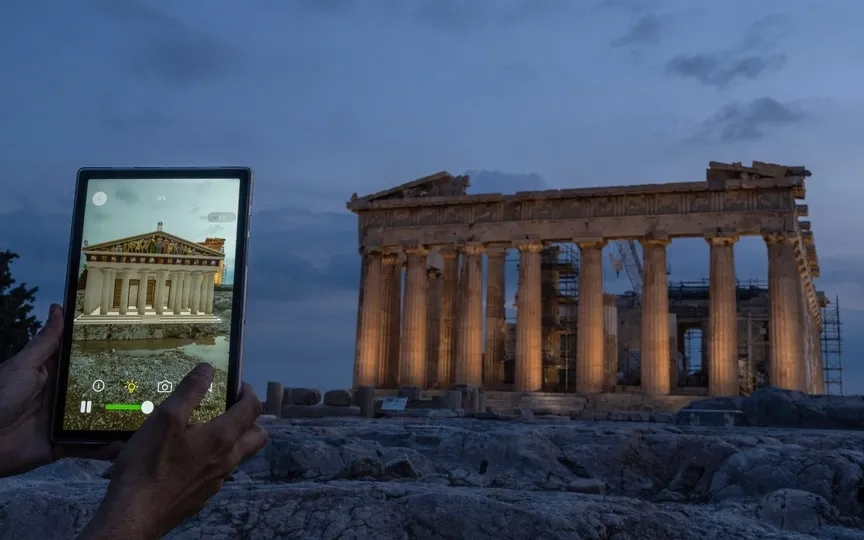Exploring the Past: A Look at How Technology Can Recreate Ancient Greek Sites
One of the world’s most contentious debates on cultural heritage will be resolved before the eyes of tourists visiting the Acropolis this holiday season.
All they need is a smartphone.
Visitors can now pinch and zoom around the ancient Greek site with a digital overlay that shows how it once looked. It contains a collection of marble sculptures that were removed from the Parthenon more than 200 years ago and are now on display at the British Museum in London. Greece has demanded their return.
For now, an app backed by the Greek Ministry of Culture allows visitors to point their phones at the Parthenon and the London-based sculptures will reappear at the monument as archaeologists believe they looked 2,500 years ago.
We are now on WhatsApp. Click to join.
There are also other, less well-known features: Many sculptures on the Acropolis were painted in striking colors. The statue of the goddess Athena in the main chamber of the Parthenon also stood on top of a shallow pool of water.
“It’s really impressive… the only time I’ve seen this kind of technology before is at the dentist,” London tourist Shriya Parsotam Chitnavis said after examining the app on a hot afternoon at the hilltop Acropolis in Greece. the most popular archaeological site.
“I didn’t know much (about the Acropolis), and I had to be allowed to come here. Seeing this has made it more interesting — seeing it in color,” he said. “I’m more of a visual person, so the interactivity really helped me appreciate it.”
Virtual restoration works anywhere and could save some visitors the crowded uphill walk and long wait to see the iconic Monuments up close. It may also help the country’s campaign to make Greek cities year-round destinations.
Tourism, vital to Greece’s economy, has bounced back since the COVID-19 pandemic, even as wildfires chased visitors from the island of Rhodes and affected other areas this summer. According to the Bank of Greece, the number of visitors arriving between January and July increased by 21.9 percent compared to 16.2 million last year. Turnover increased by slightly more than 20% to 10.3 billion euros ($10.8 billion).
Called “Chronos” after the mythological king of the Titans and the Greek word for “time,” the app uses augmented reality to place an ancient impression of the site on the screen, matching the actual view as you walk by.
AR is reaching consumers after a long wait and is expected to impact a huge range of professional and leisure activities.
Medical surgery, military training and specialized machine repair, as well as retail and live event experiences are all in the sights of major tech companies betting on a lucrative future in immersive services. Tech giants like Meta and Apple are working to develop VR headsets that can cost thousands of dollars.
The high price tag will keep the mobile phone as an AR delivery platform for consumers for some time, said Maria Engberg, co-author of “Reality Media,” a book on augmented and virtual reality.
He says services aimed at travelers will soon offer a more integrated experience, allowing for more sharing options on tours and overlaying archive photos and videos.
“AR and VR have lagged behind other things like games and movies that we consume digitally,” said Engberg, an assistant professor of computer science and media engineering at Malmö University in Sweden.
“I think we’re going to see some really interesting customer experiences in the next few years as more museum and archive content is digitized,” he said.
Greece’s Ministry of Culture and National Tourism Authority are late but excited to move to the technology. The popular video game Assassin’s Creed Odyssey, which allows players to wander around ancient Athens, attracted young travelers from China to Greece with a government-run photo contest.
Microsoft partnered with the Ministry of Culture two years ago to launch an immersive digital tour of ancient Olympia, the birthplace of the Olympic Games in southern Greece.
Culture Minister Lina Mendoni said the innovations would improve access to Greece’s ancient monuments and complement newly installed ramps and anti-slip paths.
“Accessibility is expanding into the digital space,” Mendoni said at a Chronos app preview event in May. “Real visitors and virtual visitors all over the world can share historical information.”
The designers of the free app, developed by Greek telecommunications provider Cosmote, say they hope to build on existing features, which include an artificial intelligence-powered virtual guide, Clio.
“As technologies and networks evolve, with better bandwidth and lower latency, mobile devices can download higher quality content,” said Panayiotis Gabrielides, a senior official at a telecom company involved in the project.
The virtual reconstructions made with the help of Chronos also cover three other monuments of the Acropolis, the adjacent Roman theater and parts of the Acropolis Museum built at the foot of the rock.
One more thing! We are now on WhatsApp channels! Follow us there to never miss an update from the tech world. If you want to follow ReturnByte channel on WhatsApp, click here to join now!




